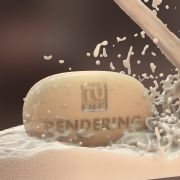Creating photorealistic images has always been an essential goal in computer graphics. The image generation process builds on a complex mathematical construct, the so-called rendering equation. This equation defines how light interacts with surfaces in a virtual scene, and involves complex surface description models that describe important effects like reflections, glossy surface interactions, and indirect illumination. Solving this equation can be achieved by investing a large amount of time and computational resources, but intelligent methods have been found that greatly speed up the calculations up to an interactive or even real-time frame rates. Both interactive as well as any non-interactive applications such as computer games, visual effects, architectural lighting simulation, urban and automotive design, disaster simulation and many other applications that depend on an accurate light simulation, profit from efficient ways to calculate light transport.
These methods can be categorized by being a part of the mathematical field of functional analysis where a large body of research exists because it forms the basis for scientific fields such as quantum mechanics, chaos and ergodic theory, vision and signal processing besides countless specialized applications in areas like structural mechanics, simulation and other engineering problems. Applications of Fourier or Laplace transformations, Spherical Harmonics or Wavelets, just to name a few important approaches, are ubiquitous.
However, despite the considerable amount of research work devoted to finding methods to calculate and analyze the complex light transport in a virtual scene, they remain challenging issues and many inherent properties of light transport are largely unknown.
Over the course of the last 10 years, a more general form of wavelets, named anisotropic wavelets that introduce directionality to the basis definitions have been proposed. In particular, curvelets and contourlets have already proven to be powerful tools in astrophysics, seismology, fluid dynamics and vision due to their unique properties optimized for natural signals.
Yet, anisotropic wavelets have not been considered for light transport, though they have several advantages over standard wavelets such as a higher sparsity or near-optimal representation. Therefore, the main goal of this project is to develop methods based on anisotropic wavelets that calculate all aspects of light transport more efficiently, delivering a higher image quality with fewer resources, including an adaptation to all principal domains used in computer graphics. Due to their properties, anisotropic wavelets also form an excellent foundation to perform a fundamental multi-scale and multi-directional analysis of light transport which leads to a better understanding and deeper into the process of light transport in virtual scenes.
Funding
- FWF P23700-N23
Research Areas
- In this area, we concentrate on algorithms that synthesize images to depict 3D models or scenes, often by simulating or approximating the physics of light.
Publications
14 Publications found:
Download list as Bibtex, HTML (Advanced, Expert), JSON (with referenced objects), CSV, Permalink
| Image | Bib Reference | Publication Type |
|---|---|---|
| 2016 | ||
 |
Karoly Zsolnai-Fehér Real-time Subsurface Scattering, Light Transport and Two Minute Papers, 2016, Intel Advanced Rendering Technology group |
Invited Talk |
| 2015 | ||
 |
Jorge Jimenez, Karoly Zsolnai-Fehér , Adrian Jarabo, Christian Freude , Adrian Jarabo, Christian Freude , Thomas Auzinger, Xian-Chun Wu, Javier van der Pahlen, Michael Wimmer , Thomas Auzinger, Xian-Chun Wu, Javier van der Pahlen, Michael Wimmer , Diego Gutierrez , Diego GutierrezSeparable Subsurface Scattering Computer Graphics Forum, 34(6):188-197, June 2015. [  paper] paper] |
Journal Paper with Conference Talk |
| Thomas Auzinger Prefiltered Anti-Aliasing on Parallel Hardware, 2015, IST Austria |
Invited Talk | |
| 2014 | ||
Karoly Zsolnai-Fehér Light Transport with a Touch of Fluids, 21. October 2014, |
Invited Talk | |
 |
Matthias Bernhard, Efstathios Stavrakis, Michael Hecher, Michael Wimmer Gaze-To-Object Mapping During Visual Search in 3D Virtual Environments ACM Transactions on Applied Perception (Special Issue SAP 2014), 11(3):14:1-14:17, August 2014. [  draft] [ draft] [ video] video] |
Journal Paper with Conference Talk |
 |
Michael Hecher, Matthias Bernhard, Oliver Mattausch, Daniel Scherzer, Michael Wimmer A Comparative Perceptual Study of Soft Shadow Algorithms ACM Transactions on Applied Perception, 11(5):5:1-5:21, June 2014. |
Journal Paper (without talk) |
 |
Silvana Podaras Automated Lighting Design For Photorealistic Rendering [  paper] paper] |
Bachelor Thesis |
| Thomas Auzinger Analytic Rasterization, 30. April 2014, Czech Technical University in Prague, Department of Computer Graphics and Interaction, Prague |
Invited Talk | |
| Thomas Auzinger GPGPU in Graphics and Visualization, 15. October 2014, Universidad de Jaén, Spain |
Invited Talk | |
 |
Sebastian Sippl Framework for Shape Segmentation |
Student Project |
| 2013 | ||
 |
Thomas Auzinger, Michael Wimmer Sampled and Analytic Rasterization Poster shown at VMV 2013 (11. September 2013-13. September 2013) In Proceedings of the 18th International Workshop on Vision, Modeling and Visualization , pages 223-224. [  Poster] Poster] |
Poster |
 |
Thomas Auzinger, Przemyslaw Musialski , Reinhold Preiner , Reinhold Preiner , Michael Wimmer , Michael Wimmer Non-Sampled Anti-Aliasing In Proceedings of the 18th International Workshop on Vision, Modeling and Visualization (VMV 2013), pages 169-176. September 2013. [  Paper] Paper] |
Conference Paper |
 |
Christian Luksch, Robert F. Tobler, Ralf Habel, Michael Schwärzler, Michael Wimmer Fast Light-Map Computation with Virtual Polygon Lights In Proceedings of ACM Symposium on Interactive 3D Graphics and Games 2013, pages 87-94. March 2013. [  draft] draft] |
Conference Paper |
| 2012 | ||
 |
Ralf Habel, Michael Kudenov, Michael Wimmer Practical Spectral Photography Computer Graphics Forum (Proceedings EUROGRAPHICS 2012), 31(2):449-458, May 2012. [  Draft] Draft] |
Journal Paper with Conference Talk |
